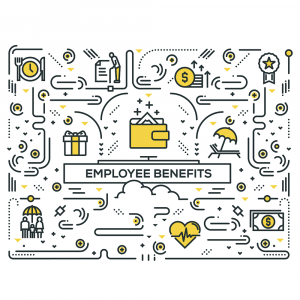Top Trends in Employee Benefits and Policies for a Post-Pandemic Workforce

In today’s upside-down economic climate, there’s no such thing as “business as usual.” Employers must adapt to fast-changing priorities, such as a remote workforce, safety guidelines for returning employees, cost containment,
and new customer-service models.
Above all, both employers and employees are worried about money. In a recent PricewaterhouseCoopers (PwC) survey, nearly 80% of CFOs are taking cost-containment measures as a result of COVID-19. And 88% of Americans say the crisis is causing stress on their personal finances.
20% of employees said they’d been a victim of identity theft.
PwC’s 8th annual Employee Financial Wellness Survey
During these uncertain times, many employees rely on their employers for additional financial and emotional support. “A stunning 90% of our survey respondents want companies and brands to do everything they can to protect the well-being and financial security of their employees and suppliers, even if it means suffering big financial losses during the pandemic,” Jennifer Cohan, president of Edelman New York, told Forbes.
How to Support Employee Wellness in the “New Normal”
But just what does it mean to protect employees’ “well-being and financial security”? What kind of help do employees want?
A 2020 MetLife study on employee benefits trends identified four components of employee well-being—financial, physical, emotional, and social—indicating that employees need support in managing a “blended work-life world.” Here are a few relatively low-cost policies and benefits employers can adopt to help their people cope with the financial and emotional stressors of this pandemic:
Policies
- Flexible work. For many, working from home (WFH) eases worries about childcare, cuts down on costly commutes, and reduces overall stress. Even when the office reopens, companies may consider offering some employees long-term remote-work opportunities, such as Twitter, Amazon, and Facebook have done.
Another option is non-traditional hours for both onsite and remote workers. One human resources expert suggests requiring employees to be on the job during core office hours, such as between 10 a.m. and 2 p.m. Beyond that, they can choose to work from 6 a.m. to 2 p.m. or 10 a.m. to 6 p.m.—whatever serves their needs. - Job sharing or part-time professional work. This is another flexible work policy that can be a win-win for both employers and workers. Whether two people share a full-time job or simply work part-time, they’re often more productive and focused at work—they have more time to take care of personal matters. On the flip side, part-time or job-sharing employees appreciate the fact they can maintain their professional skill sets and prevent gaps in their work experience.
Paid Benefits
- Wellness programs. According to the MetLife survey, employers can especially provide greater support with mental health and financial wellness when it comes to better managing work-life stress. Employee Assistance Programs (EAPs), for example, offer free counseling to help with stress management, family dynamics, work, and other concerns.
- Student-loan repayment. Employees, particularly millennials, rank this benefit high. Companies can offer it in a number of creative ways, such as making 401(k) matching contributions tied to workers’ student-loan payments or letting employees trade unused vacation days for help with student debt. For a more direct approach, employers can enable payments through payroll deferral or offer onsite financial advice.
- Community discounts. Consider supporting local businesses by offering employee discounts to the gym, dry cleaner, restaurants, or housecleaning service. Ask employees for input on what products and services they prefer and will actually use.
- Privacy and identity protection. In a PwC 2019 Employee Financial Wellness Survey, 20% of employees said they’d been a victim of identity theft. That number could go up, since the pandemic brought on a scourge of COVID-19-related scams, from unemployment fraud to Zoombombing attacks.
In fact, IDX’ members have experienced a 50% increase in the number of targeted scams and phishing attacks via email, call, and texts since the stay-at-home-order began. Privacy-focused identity protection with strong detection capabilities helps employees safeguard against these and other growing threats.
The cost of privacy and identity protection as an employee benefit is comparable to the price of coffee. Tom Kelly, IDX’ president and CEO, said, “Americans spend an average of $1,100 each year on coffee. A top-tier identity theft protection plan costs less than a quarter of that.” With digital threats on the rise, now is a prime opportunity for companies to invest in employee peace of mind and mitigate the expenses incurred by identity theft or fraud.
In the days ahead, employees will increasingly rely on their places of work for both emotional and financial support. These policies and benefits allow a business to show that they prioritize employee wellness and provide reassurance—something we all will need.
About IDX
We're your proven partner in digital privacy protection with our evolving suite of privacy and identity products.




